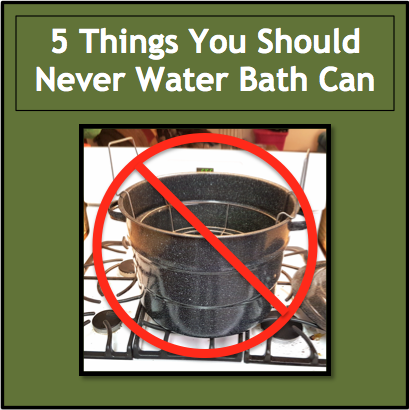I’ve learned an awful lot about canning over the last few years! From falsely sealed lids to broken jars, I’ve definitely had my share of bumps in the road. Thankfully, no one has ever gotten sick from any of my mistakes. I chalk that up to being a stickler for doing things right and not taking risks. Through it all, I’ve also learned there are certain things you should never water bath can. Ever.
Now, before people start in with “But my grandmother did thus-and-so and we never got sick!” let me be clear: Just because it was done in a certain way back in the day doesn’t mean it is the ‘right’ way. Times change, new information is learned, better equipment is available and so on. The food itself also changes over time. That is the nature of life – always changing and adapting! The potatoes you eat today are assuredly not what they were like 100 years ago. Even if you take out the chemical factor, there would still be differences.
The main reason these 5 foods listed below shouldn’t be water bath canned is because they don’t have enough acid in them to inhibit bacteria growth. You need to have a high acid environment for water bath canning. Pressure canning is different because the temperature gets much higher and you also process for considerably longer. For more information about the difference between water bath canning and pressure canning, click here!
Meat
Meat is one of the foods that should always, without question, be pressure canned. Never water bath canned. The reason is because of the lack of acidity. Bacteria can more easily grow inside the food, even cooked meat, unless brought up to 240 degrees F and then sealed.
The wonderful world of home canned meat creates shelf stable protein that doesn’t require refrigeration. You can just pop open a jar, heat and eat! It also extends the life of the food you already paid for by at least 12 months. If you don’t have very much meat to process and don’t want to waste the time for just a few jars, consider making meals in a jar instead! The processing time is the same so why not make some ready to eat meals of your own?!
Stock (Meat or Vegetable)
Vegetable and meat stocks are another thing that should never be water bath canned. Even though, especially with vegetables, you are basically boiling water, the bottom line is a water bath canner doesn’t get the contents hot enough to ensure all bacteria has been neutralized. It’s not worth getting sick!
Green Beans
Yes, I know. Your grandmother, great grandmother, aunts, and cousins’ mothers all water bath canned green beans and there were just fine. No sickness. I understand that. How you choose to can your food is up to you and I don’t judge. To each their own. For myself, I follow the USDA standards found here. Now, I don’t claim to be perfect. Far from it! I do, however, do my best to follow the standards and the guide that came with my pressure canner.
There IS a way you can water bath can your green beans though! Make Dilly Beans! Pickled green beans are delicious!
Carrots
Who doesn’t love opening their pantry and seeing jars of bright orange carrots smiling back at them? Carrots are one of my most favorite things to grow but they have about as much acidity as a piece of paper. Therefore, they should always be pressure canned. Thankfully, they take considerably less time than canning meat does.
Again, if you pickle the carrots, you can water bath can them. Otherwise, it’s the pressure canner to be safe!
Tomatoes
Many will balk at this one. “But Homestead Dreamer, tomatoes are full of acid. No bacteria can grow! Water bath canning is how <insert relative here> always did it!”
While it’s common knowledge that tomatoes have a higher acidity level than most vegetables, the truth is that most tomatoes sold in stores are low-acid varieties. There are some ways you can still water bath can them, such as adding lemon juice or ascorbic acid to them, but is the risk really worth it?
Tomatoes also don’t take very long to pressure can and I would rather have peace of mind versus saving an hour’s worth of time and potentially having to toss the whole batch later. Better safe than sorry!
If you would like to learn more about canning, try one of the links below!
Water Bath Canning vs Pressure Canning
Unraveling the Mystery: Water Bath Canning
Going From a Complete Newbie to a Confident Canner





What pressure and for how long do you do tomatoes, etc??
You need to check your pressure canner’s instructions to be double sure but in general, at sea level it would be 11 pounds of pressure for 20 minutes on pints and 25 minutes on quarts.
Pressure canning can be very intimidating for anyone new to canning, but once you get the hand of it, it is fairly easy. I’d highly recommend the Ball canning book which has some wonderful step by step instructions on the process to go a long with some recipes.